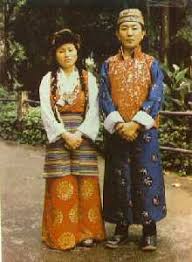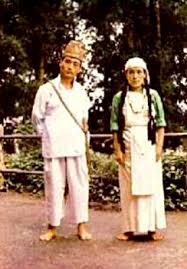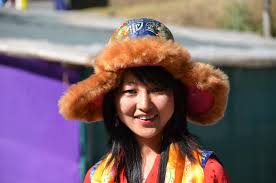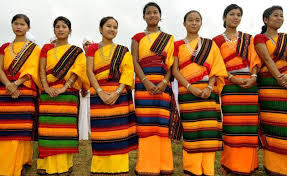source(google.com.pk)
Traditional Dresses Of Sikkim Biography
The Bhutia (in Sikkim: Denzongpa; Tibetan, Wylie: 'Bras-ljongs-pa; "inhabitants of Denzong;" in Bhutan: Dukpa) are a community of people of Tibetan ancestry, who speak Sikkimese, a Tibetan dialect fairly mutually intelligible to standard Tibetan. In 2001, the Bhutia numbered around 70,300. Bhutia here refers to Sikkimese of Tibetan ancestry; in contrast, the Bhotiya are a larger family of related Tibetan peoples in northern Nepal of which the Bhutia are one member group.
Clothing
The traditional outfit of Bhutias is called a bakhu (similar to the Tibetan chuba, but sleeveless) which is a loose cloak type garment that is fastened at the neck on one side and near the waist with a silk/cotton belt. Male members array the bakhu with a loose trouser. The womenfolk don the bakhu with a silken full sleeve blouse called honju; a loose gown type garment fastened near the waist, tight with a belt. In the front portion a loose sheet of multi-coloured woollen cloth with exotic geometric designs is tied. This is called the pangden and is a symbol of a married woman. This traditional outfit is complemented by embroidered leather boots by both men and women. Bhutia women enjoy a much higher status than their counterparts from other communities. Both women and men have a special weakness for gold in its purest form and, traditional jewellery is mostly made of 24 carats (100%) gold.
Kho (costume)
Kho (Bhutia) or Bakhu (Nepali) is a traditional dress worn by Bhutia, ethnic Tibetans of Sikkim. It is a loose cloak type garment that is fastened at the neck on one side and near the waist with a silk or cotton belt, similar to the Tibetan chuba, but sleeveless.
Women wear a silken full sleeve blouse called honju inside the kho; a loose gown type garment fastened near the waist, tightened with a belt. Married women tie a multi-coloured striped apron of woolen cloth called pangden around their waist.
Male members wear a loose trouser under the kho. The traditional outfit is complemented by embroidered leather boots by both men and women.
the aboriginal people of Sikkim, who number between 30,000 and 50,000. Many Lepcha are also found in western and southwestern Bhutan, Tibet, Darjeeling, the Ilam District of eastern Nepal, and in the hills of West Bengal. The Lepcha people are composed of four main distinct communities: the Renjóngmú of Sikkim; the Támsángmú of Kalimpong, Kurseong, and Mirik; the ʔilámmú of Ilam District, Nepal; and the Promú of Samtse and Chukha in southwestern Bhutan.
Clothing
The traditional clothing for Lepcha women is the ankle-length dumdem, also called dumdyám ("female dress"). It is one large piece of smooth cotton or silk, usually of a solid color. When it is worn, it is folded over one shoulder, pinned at the other shoulder, and held in place by a waistband, or tago, over which excess material drapes. A contrasting long-sleeved blouse may be worn underneath
The traditional Lepcha clothing for men is the dumprá ("male dress"). It is a multicolored, hand-woven cloth pinned at one shoulder and held in place by a waistband, usually worn over a white shirt and trousers. Men wear a flat round cap called a thyáktuk, with stiff black velvet sides and a multicolored top topped by a knot. Rarely, the traditional cone-shaped bamboo and rattan hats are worn.










Traditional Dresses Of Sikkim Biography
The Bhutia (in Sikkim: Denzongpa; Tibetan, Wylie: 'Bras-ljongs-pa; "inhabitants of Denzong;" in Bhutan: Dukpa) are a community of people of Tibetan ancestry, who speak Sikkimese, a Tibetan dialect fairly mutually intelligible to standard Tibetan. In 2001, the Bhutia numbered around 70,300. Bhutia here refers to Sikkimese of Tibetan ancestry; in contrast, the Bhotiya are a larger family of related Tibetan peoples in northern Nepal of which the Bhutia are one member group.
Clothing
The traditional outfit of Bhutias is called a bakhu (similar to the Tibetan chuba, but sleeveless) which is a loose cloak type garment that is fastened at the neck on one side and near the waist with a silk/cotton belt. Male members array the bakhu with a loose trouser. The womenfolk don the bakhu with a silken full sleeve blouse called honju; a loose gown type garment fastened near the waist, tight with a belt. In the front portion a loose sheet of multi-coloured woollen cloth with exotic geometric designs is tied. This is called the pangden and is a symbol of a married woman. This traditional outfit is complemented by embroidered leather boots by both men and women. Bhutia women enjoy a much higher status than their counterparts from other communities. Both women and men have a special weakness for gold in its purest form and, traditional jewellery is mostly made of 24 carats (100%) gold.
Kho (costume)
Kho (Bhutia) or Bakhu (Nepali) is a traditional dress worn by Bhutia, ethnic Tibetans of Sikkim. It is a loose cloak type garment that is fastened at the neck on one side and near the waist with a silk or cotton belt, similar to the Tibetan chuba, but sleeveless.
Women wear a silken full sleeve blouse called honju inside the kho; a loose gown type garment fastened near the waist, tightened with a belt. Married women tie a multi-coloured striped apron of woolen cloth called pangden around their waist.
Male members wear a loose trouser under the kho. The traditional outfit is complemented by embroidered leather boots by both men and women.
the aboriginal people of Sikkim, who number between 30,000 and 50,000. Many Lepcha are also found in western and southwestern Bhutan, Tibet, Darjeeling, the Ilam District of eastern Nepal, and in the hills of West Bengal. The Lepcha people are composed of four main distinct communities: the Renjóngmú of Sikkim; the Támsángmú of Kalimpong, Kurseong, and Mirik; the ʔilámmú of Ilam District, Nepal; and the Promú of Samtse and Chukha in southwestern Bhutan.
Clothing
The traditional clothing for Lepcha women is the ankle-length dumdem, also called dumdyám ("female dress"). It is one large piece of smooth cotton or silk, usually of a solid color. When it is worn, it is folded over one shoulder, pinned at the other shoulder, and held in place by a waistband, or tago, over which excess material drapes. A contrasting long-sleeved blouse may be worn underneath
The traditional Lepcha clothing for men is the dumprá ("male dress"). It is a multicolored, hand-woven cloth pinned at one shoulder and held in place by a waistband, usually worn over a white shirt and trousers. Men wear a flat round cap called a thyáktuk, with stiff black velvet sides and a multicolored top topped by a knot. Rarely, the traditional cone-shaped bamboo and rattan hats are worn.
Traditional Dresses Of Sikkim
Traditional Dresses Of Sikkim
Traditional Dresses Of Sikkim

Traditional Dresses Of Sikkim
Traditional Dresses Of Sikkim
Traditional Dresses Of Sikkim

Traditional Dresses Of Sikkim

Traditional Dresses Of Sikkim
Traditional Dresses Of Sikkim
Traditional Dresses Of Sikkim
Traditional Dresses Of Sikkim
Hi do you know where to find such costumes in Singapore?i do look forward to your reply. Thank you:)
ReplyDelete